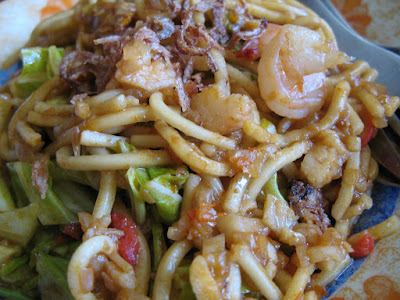
Before I take a month long break from my food blogging, I thought I'll post something quick and simple, good when you're cooking for one.
Unfortunately, my rosemary pot has died, after being eaten by bugs, and suffering from 2 weeks of drought. So I had to use dried ones, which is not so bad though.
The roasted potato recipe comes from Jamie's guide to making me a better cook. It's quite straightforward, so after cooking it once, you can almost remember how to do it without referring back to the recipe.
To complete the meal, I did a quick stir fry of beef and onion, in the same pot used for boiling potatoes. In this way, I minimised my washing.
Rosemary Roasted Potato Cubes with Quick Beef Stirfry
Serves one
2 small washed potatoes, cut into 1 cm cubes. Keep skin if they're washed
Rosemary
olive oil
3 cloves garlic, crushed
a handful of sliced beef
1 onion
salt and black pepper
Preheat oven to 220 degree Celsius.
Cut potatoes into cubes. Put them into a pan of cold water and boil. When potatoes are boiling, drain in colander and leave to steam for a while.
Meanwhile, put olive oil on a roasting tray (or oven proof pyrex dish) and put into the oven to heat up the oil.
When the oil is hot, take out the tray and toss potatoes, rosemary, crushed garlic. It'll sizzle like teppanyaki which is kinda fun. Season with salt and pepper. Return to oven and bake for 20-25 minutes. Stir or shake the potato cubes once in a while to help in achieving a golden crispy texture.
Just before the potatoes are done, heat a little olive oil in pan. Fry onions until they are soften and a little brown. Add beef and fry for about 2 minutes. Season with salt and black pepper. Add a little water if you find it drying too much.
Toss the beef stir fry into the potatoes and serve.
And of course, you could cook something else to go with the potatoes.



























